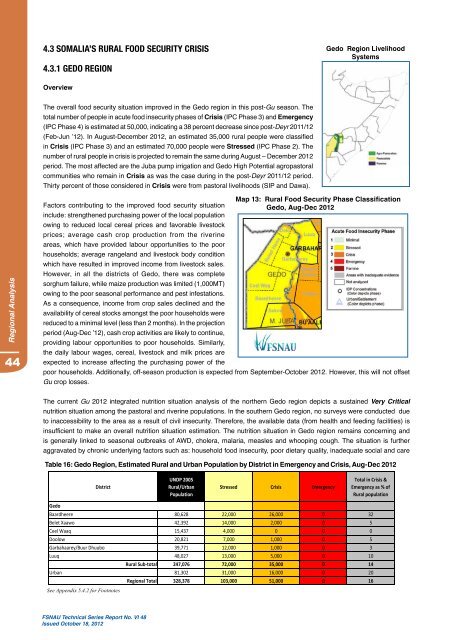Fsnau-Post-Gu-2012-Technical-Report
Fsnau-Post-Gu-2012-Technical-Report
Fsnau-Post-Gu-2012-Technical-Report
Create successful ePaper yourself
Turn your PDF publications into a flip-book with our unique Google optimized e-Paper software.
Regional Analysis<br />
44<br />
4.3 SOMALIA’S RURAL FOOD SECURITY CRISIS<br />
4.3.1 GEDO REGION<br />
Overview<br />
The overall food security situation improved in the Gedo region in this post-<strong>Gu</strong> season. The<br />
total number of people in acute food insecurity phases of Crisis (IPC Phase 3) and Emergency<br />
(IPC Phase 4) is estimated at 50,000, indicating a 38 percent decrease since post-Deyr 2011/12<br />
(Feb-Jun ’12). In August-December <strong>2012</strong>, an estimated 35,000 rural people were classified<br />
in Crisis (IPC Phase 3) and an estimated 70,000 people were Stressed (IPC Phase 2). The<br />
number of rural people in crisis is projected to remain the same during August – December <strong>2012</strong><br />
period. The most affected are the Juba pump irrigation and Gedo High Potential agropastoral<br />
communities who remain in Crisis as was the case during in the post-Deyr 2011/12 period.<br />
Thirty percent of those considered in Crisis were from pastoral livelihoods (SIP and Dawa).<br />
Map 13: Rural Food Security Phase Classification<br />
Factors contributing to the improved food security situation<br />
Gedo, Aug-Dec <strong>2012</strong><br />
include: strengthened purchasing power of the local population<br />
owing to reduced local cereal prices and favorable livestock<br />
prices; average cash crop production from the riverine<br />
areas, which have provided labour opportunities to the poor<br />
households; average rangeland and livestock body condition<br />
which have resulted in improved income from livestock sales.<br />
However, in all the districts of Gedo, there was complete<br />
sorghum failure, while maize production was limited (1,000MT)<br />
owing to the poor seasonal performance and pest infestations.<br />
As a consequence, income from crop sales declined and the<br />
availability of cereal stocks amongst the poor households were<br />
reduced to a minimal level (less than 2 months). In the projection<br />
period (Aug-Dec ’12), cash crop activities are likely to continue,<br />
providing labour opportunities to poor households. Similarly,<br />
the daily labour wages, cereal, livestock and milk prices are<br />
expected to increase affecting the purchasing power of the<br />
poor households. Additionally, off-season production is expected from September-October <strong>2012</strong>. However, this will not offset<br />
<strong>Gu</strong> crop losses.<br />
The current <strong>Gu</strong> <strong>2012</strong> integrated nutrition situation analysis of the northern Gedo region depicts a sustained Very Critical<br />
nutrition situation among the pastoral and riverine populations. In the southern Gedo region, no surveys were conducted due<br />
to inaccessibility to the area as a result of civil insecurity. Therefore, the available data (from health and feeding facilities) is<br />
insufficient to make an overall nutrition situation estimation. The nutrition situation in Gedo region remains concerning and<br />
is generally linked to seasonal outbreaks of AWD, cholera, malaria, measles and whooping cough. The situation is further<br />
aggravated by chronic underlying factors such as: household food insecurity, poor dietary quality, inadequate social and care<br />
Table 16: Gedo Region, Estimated Rural and Urban Population by District in Emergency and Crisis, Aug-Dec <strong>2012</strong><br />
District<br />
FSNAU <strong>Technical</strong> Series <strong>Report</strong> No. VI 48<br />
Issued October 18, <strong>2012</strong><br />
UNDP 2005<br />
Rural/Urban<br />
Population<br />
Stressed Crisis Emergency<br />
Gedo Region Livelihood<br />
Systems<br />
Total in Crisis &<br />
Emergency as % of<br />
Rural population<br />
Gedo<br />
Baardheere 80,628 22,000 26,000 0 32<br />
Belet Xaawo 42,392 14,000 2,000 0 5<br />
Ceel Waaq 15,437 4,000 0 0 0<br />
Doolow 20,821 7,000 1,000 0 5<br />
Garbahaarey/Buur Dhuubo 39,771 12,000 1,000 0 3<br />
Luuq 48,027 13,000 5,000 0 10<br />
Rural Sub‐total 247,076 72,000 35,000 0 14<br />
Urban 81,302 31,000 16,000 0 20<br />
Regional Total 328,378 103,000 51,000 0 16<br />
See Appendix 5.4.2 for Footnotes


